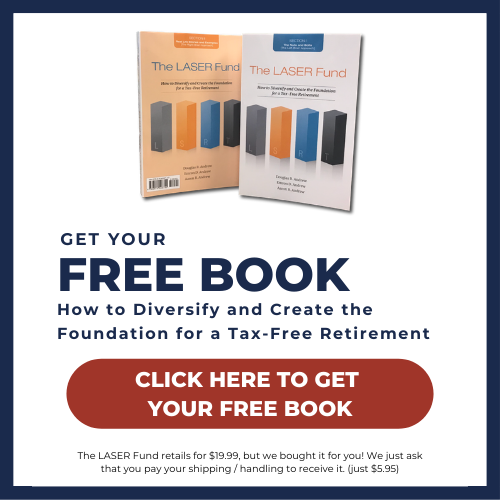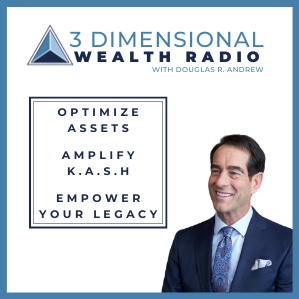Let’s say you have $1 million to invest for retirement. What’s the one thing you should do so you can enjoy $100,000 a year in tax-free income during retirement…and it’s not what everyone else is telling you.
I often get asked, “What should I do with this $1 million I want to set aside for retirement?” Even if you don’t have $1 million to set aside right now, you’re probably wondering the same thing: What’s the best place to put my serious money so I don’t outlive it during retirement?
Get ready; I’m going to show you absolutely the best place to invest $ 1 million if it were me. And I’ve advised thousands of people on how to generate an average of up to 10% payouts (depending on market performance and what have you) on a million bucks, which means up to $100,000 a year of tax free income.
SO … I HAVE A LUMP SUM
Let me start with a little story. I had an individual come to me who had recently received a million-dollar settlement, saying, “Doug, I have a million dollars. Now I want to make sure that I do not lose this million.”
I told him I would never recommend that you put that $1 million in the market. I’ve seen people with $1 million dollars one day, and a year later, they only had $600,000 to show for it. That happened in 2008 when the market crashed–millions of Americans lost 40% of their 401(k)s and IRAs in a single year.
So no, you don’t want to put it in the market. The market is designed to encourage you to keep it there. When you ask Wall Street, “When is the best time to take money out of the market?” They will always say, “Never. When the market dives, hang in there. The market always comes back.” While the markets typically make it back, it often takes years to do so. If you’re at or near retirement, you don’t exactly have “years” to spare. The reality is, traditional investing was never designed to provide safe growth and tax-free income.
But most people don’t want to lose their money while they’re trying to give it a chance to grow. People tell me all the time, “Doug, I don’t want to lose my principal. I want safety of principal.”
DOES YOUR FINANCIAL VEHICLE PASS THE LASER TEST?
I couldn’t agree more, that’s why I tell everyone to put retirement vehicles to the LASER test. LASER is an acronym of mine that stands for Liquid Assets Safely Earning Returns. Optimally, you want financial vehicles that can provide the LASER essentials:
- Liquidity – The ability to access your cash whenever you need it (ideally with little to no penalties, taxes or fees)
- Safety – The ability to protect your principal from loss, as well as safety of the institution in which your money is entrusted
- Rate of return – The goal here is to earn a competitive rate of return that historically has beaten inflation, and if you can have that rate of return under tax-favorable circumstances, it will dramatically increase not only the end result, but also the net spendable income available during your “harvest” years
- Tax advantages – Ideally you want to have tax advantages when your money is growing, when you access your money, and when you transfer your money to your heirs upon your passing
Take a moment now to consider your current financial strategies. How well do they deliver on liquidity, safety, rate of return, and tax advantages? We’ve developed a proprietary LASER Rating System™ that helps examine specific financial products’ uses and risks, as compared to other financial vehicles.
I talk about this in my book, “The LASER Fund,” where I also provide a LASER Scorecard so you can perform your own analysis on each of your current financial vehicles. You can use the scorecard to rate how they fare with liquidity, safety, rate of return, and tax advantages.
[To check out the LASER scorecard in “The LASER Fund” book (Section I, p. 52). You can order your free copy of the book today at LASERFund.com; just pay shipping and handling.]
HOW DOES A LASER FUND WORK?
So back to the story, when I was discussing this with the individual who was looking for a place to put his million-dollar settlement, I told him, “Wherever I recommend people put money, serious cash that they don’t want to jeopardize, you want to make sure it’s liquid. Liquidity is number one, the ability to access the money when you need it with an electronic funds transfer or a phone call.”
He said, “That sounds good to me.” Then I continued, “The number two priority is safety.”
He clarified, “Safety of the institution?” I said, “Absolutely, I put my money in the institutions that have weathered the Great Depression with flying colors, the last industry that would collapse if the American dollar became worthless.”
“What industry is that?” he asked. I said, “The multi-trillion dollar insurance industry, the one that’s the backbone of America, of the world. It’s where governments go for help or money when they need it. It’s where banks and credit unions take the money we deposit into them, in insurance companies. (It’s called BOLI, Bank Owned Life Insurance.) Banks “borrow” the money we deposit and pay us 1% or 2% interest. Then they turn around and increase the safety by six notches or so, because most of the top insurance companies (the same ones I recommend) are rated AAA. Most banks are only rated triple B. That’s six notches lower in safety. So banks increase the safety on the money you give them and then they increase the rate of return. They’re paying you one or 2% and they’re earning 5% or 6% in the insurance companies.
“So I’m saying, why don’t you do what banks do, bypass the middleman with this? Choose a financial vehicle that gives you liquidity and safety. Then number three, you want to earn predictable rates of return, not pie in the sky rates of return. You don’t need 15%, 20%, or even 30%. There will be some years you might earn that, but more important than that, you want to avoid losing your principal when the market goes down.
“The offset of that is, you may not make much or even anything during a down year, but you will make money when the market goes up. Would an average return, sir, of 10% net sound good? And would a 0% floor feel good protecting your principal when the market tanks?”
He said, “That sounds too good to be true.” I said, “Well, it’s not. I have actually averaged 10.07% net after all costs and fees with a maximum-funded indexed universal life policy, what I call a LASER Fund, for over 25 years.” He repeated, “This really sounds too good to be true.”
Important Note: Due to regulatory guidelines, you will often see a much more conservative approach illustrated when designing your policy. While I have personally averaged 10.07%, your experience will be different. The key is working with a qualified IUL Specialist who understands best practices needed to accomplish this. Most financial professionals have no idea how to do this.
Then I showed him an illustration, the same kinds of illustrations that are in “The LASER Fund” book. I showed him how he could fund a similar policy, property structured, with his $1 million over four years and one day (to be in compliance with IRS tax citations TEFRA, DEFRA, and TAMRA). I showed him how structuring his policy correctly, and complying with those regulations and three sections of the Internal Revenue Code, Section 72e, 7702, and 101a, could empower that million dollars to accumulate tax-free for the rest of his life. And when he chooses to take income, he can borrow it from his policy anytime, income-tax-free. And when he dies, that million blossoms to about $2.5 million as a death benefit that passes on to his heirs totally tax free.
No other vehicle does that.
He said, “Wait a minute. You mean my million dollars, if I don’t touch it, can double to $2 million in about seven to seven and a half years?” I said, “Yep.”
He asked, “What if I leave it another seven and a half years? Will it grow by another million?” I clarified, “No. It can double from $2 million to $4 million. Then $4 million can double to $8 million. It just doesn’t grow by another million every 7.2 years; it can double. Many of my clients have done that.”
He said, “What if I need income?” I explained, “If you need income, when it only has $1 million in it, it can generate up to 10%. Borrow 10% of that from your policy. That’s $100,000 a year, without depleting your principal.”
He said, “This is incredible. My banker tells me to put it in the bank where it’s safe, and he said they don’t charge fees…but the LASER Fund seems so much better.” I countered, “Oh, the bank costs you plenty, but it’s hidden; they don’t call them fees. They take your money and they earn 5%, 6%, 7%, or 8%.
What is it costing you to put your money in the bank?
I’d say it’s on average about 7% of $1 million that you’re missing out on, essentially costing you $70,000. They don’t charge you $70,000. They just pay you a nominal interest rate of 1%, which is costing you $70,000 or so of what you otherwise could earn in a LASER Fund. And with a LASER Fund, your money would be in an institution that ranks six notches higher in safety.”
He asked, “How come nobody ever told me this before??”
BETTER LATE THAN NEVER
Well, better to learn it now than never.
And to you as readers, I hope it helps you just the same to consider the options you have–and I encourage you to explore how a LASER Fund can make a difference in your financial future.
WANT TO LEARN MORE?
Watch the Video – Watch the related YouTube video to see me explain “How to Invest One Million for Retirement” (and while you’re there, be sure to subscribe to my YouTube channel so you don’t miss a thing!).
Explore the Ins & Outs of The LASER Fund – Find out how you can improve your Financial Dimension journey and seize the liquidity, safety, predictable rates of return, and tax advantages of a LASER Fund. Explore the in-depth financial strategies and learn from real-life client experiences by claiming your free copy of “The LASER Fund” book at LASERFund.com. Just pay for shipping and handling, and we will send it to you, absolutely free.
Join a Webinar – Want to find out if a LASER Fund (a maximum-funded, properly structured indexed universal life insurance policy) is right for you? Join us for an upcoming webinar where you can explore these strategies.


